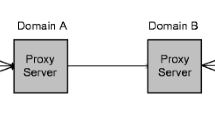Abstract
Interconnection among VoIP networks over the Internet is being an important trend. Therefore, distributed and self-organized VoIP networks are emerging as the times require. Because of VoIP’s cheapness and simplicity, many institutes forecast that it emerges as next spam entryway, like e-mail service. Especially, interconnected VoIP networks are self-organized and lack centralized authority. In this paper, we propose a novel scheme, called ADVS (Anti-Distributed Voice Spam), against SPIT (SPam over Internet Telephony) on the distributed and self-organized VoIP networks. ADVS presents a proper reputation model to evaluate end-user’s past behavior and accumulate other users’ referrals for detecting and filtering spam calls. In the VoIP network, ADVS acts as a middleware of VoIP proxy and constructs a DHT-based P2P network over call proxies and part of P2P-VoIP client to interlink each other and share end-user’s reputation. At the end of the paper, we verify AVDS through building simulation test bed. The results of experiment show that ADVS could detect spam calls accurately and stably.
Similar content being viewed by others
References
Albrecht K, Burri N, Wattenhofer R (2005) Spamato: an extendable spam filter system. In: 2nd Conference on email and anti-spam Stanford University, Palo Alto, California, USA, Jul 2005
Albrecht K, Wattenhofer R (2006) The TROOTH recommendation system. In: International conference on Internet and web applications and services/advanced, Feb 2006
Boykin PO, Roychowdhury VP (2005) Leveraging social networks to fight spam. Computer 38(4):61–68
Damiani E, De Capitani di Vimercati S, Paraboschi S, Samarati P (2004) P2P-based collaborative spam detection and filtering. In: Proc. 4th IEEE conf on P2P, August 2004
Damiani E, De Capitani di Vimercati S, Paraboschi S et al (2004) P2P-based collaborative spam detection and filtering. In: Proceedings of the 4th IEEE conf on P2P, Aug 2004
Dantu R, Kolan P (2005) Detecting spam in VoIP networks. In: USENIX. SRUTI ’05 workshop, Cambridge MA, Jul 2005, pp 31–37
FIPS 180-1 (1995) Secure Hash Standard. U.S. Department of Commerce/NIST, National Technical Information Service, Springfield, USA, Apr 1995
(2006) General technical requirements for Softswitch equipment (in Chinese). YD/T 1434-2006
(2007) http://www.telegeography.com/products/voip/pdf/USVoIP_Exec_Summ.pdf
(2007) http://www.telegeography.com/products/euro_voip/samples/Executive_Summary.pdf
(2007) http://www.telegeography.com/products/tg/pdf/tg08_exec_toc_lof.pdf
Lazzari L, Mari M, Poggi A (2005) A collaborative and multi-agent approach to e-mail filtering. In: IEEE international conference on intelligent agent technology
Lazzari L, Mari M, Poggi A (2005) CAFE-collaborative agents for filtering e-mails. In: Proc. of the 14th IEEE international workshops on enabling technologies: infrastructure for collaborative enterprise, Linkoping, Sweden, June 2005, pp 356–361
Liu Z, Lin W, Li N, Lee D (2005) Detecting and filtering instant messaging spam—a global and personalized approach. In: Secure network protocols, the 1st IEEE ICNP workshop, 2005, pp 19–24
MacIntosh R, Vinokurov D (2005) Detection and mitigation of spam in IP telephony networks using signaling protocol analysis. In: IEEE advances in wired and wireless communication, Apr 2005, pp 49–52
Maymounkov P, Mazieres D (2002) Kademlia: A peer-to-peer information system based on the XOR metric. In: Proceedings of IPTPS02, Cambridge, USA, March 2002
Niccolini S (2006) Requirements and methods for SPIT identification using feedbacks in SIP. draft-niccolini-sipping-feedback-spit-00, IETF, February 2006
Niccolini S (2007) Signaling TO Prevent SPIT (SPITSTOP) reference scenario. draft-niccolini-sipping-spitstop-00, IETF, Jan 2007
Quittek J, Niccolini S, Tartarelli S et al (2007) Detecting SPIT calls by checking human communication patterns. In: IEEE proceedings of ICC, pp 1979–1984
Rebahi Y, Sisalem D (2005) SIP service providers and the spam problem. In: IEEE proceeding of the 2nd workshop on securing voice over IP, June 2005
Rosenberg J (2002) SIP: Session Initiation Protocol. RFC3261, Jun 2002
Rosenberg J (2006) The Session Initiation Protocol (SIP) and spam. draft-ietf-sipping-spam-03, IETF, Mar 2006
Sahami M, Dumais S, Horvitz E (1998) A Bayesian approach to filtering junk e-mail. In: Learning for text categorization—papers from the AAAI workshop, pp 55–62
Schlegel R, Niccolini S, Tartarelli S et al (2006) Spam over Internet Telephony (SPIT) prevention framework. In: IEEE proceedings of GLOBECOM
Singh K, Schulzrinne H (2005) Peer-to-Peer Internet Telephony using SIP. In: NOSSDAV’05, Washington, USA, Jun 2005. ACM Press, New York, pp 63–68
Stoica I, Morris R, Karger D, Kaashoek M, Balakrishnan H (2001) Chord: a scalable peer-to-peer lookup service for Internet applications. In: Proc. of the SIGCOMM 2001, San Diego, USA, August 2001
Turing A (1950) Computing machinery and intelligence. Originally published by Oxford University Press on behalf of MIND (J Mind Assoc) (236): 433–460
Ved Prakash V, O’Donnell A (2005) Fighting spam with reputation systems. ACM Queue 3:36–41
Yu B, Singh MP (2002) An evidential model of distributed reputation management. In: Proceedings of the first international joint conference on autonomous agents and multi-agent systems, Bologna, Italy, July 2002, pp 294–301
Author information
Authors and Affiliations
Corresponding author
Rights and permissions
About this article
Cite this article
Wang, F., Wang, F.R., Huang, B. et al. ADVS: a reputation-based model on filtering SPIT over P2P-VoIP networks. J Supercomput 64, 744–761 (2013). https://doi.org/10.1007/s11227-010-0545-5
Published:
Issue Date:
DOI: https://doi.org/10.1007/s11227-010-0545-5




